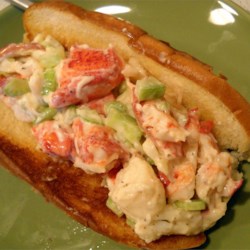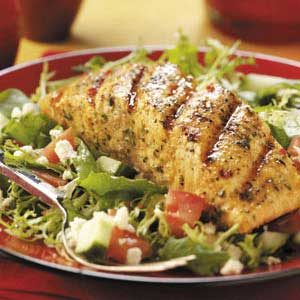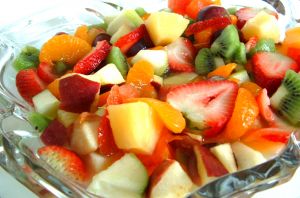Source: (Google.com.pk)
This article is about the type of culinary dish. For other uses, see Salad (disambiguation).
Salad
Salad platter.jpg
A garden salad consisting of lettuce, cucumber, scallions, cherry tomatoes, olives, sun-dried tomatoes, and cheese
Main ingredients A base of vegetables, fruits, meat, eggs, or grains mixed with a sauce.
Variations Many
Cookbook:Salad Salad
A spinach salad with various ingredients
Salad is a dish consisting of small pieces of raw or cooked food mixed with a sauce and almost always served cold.[1][2] Salads can be based around a wide variety of foods including vegetables, fruits, and cooked meat, eggs, and grains. Garden salads use a base of leafy greens; they are common enough that the word salad alone often refers specifically to garden salads. Other types include bean salad, tuna salad, fattoush, Greek salad, and somen salad.
The sauce used to a flavor a salad is commonly called a salad dressing; well-known types include ranch, Thousand Island, and vinaigrette.
Most salads are served cold, although some, such as south German potato salad, are served warm. Some consider the warmth of a dish a factor that excludes it from the salad category calling the warm mixture a casserole, a sandwich topping or more specifically, name it for the ingredients which comprise it.
Salads may be served at any point during a meal, such as:
Appetizer salads, light salads to stimulate the appetite as the first course of the meal.
Side salads, to accompany the main course as a side dish.
Main course salads, usually containing a portion of heartier fare, such as chicken breast or slices of beef.
Palate-cleansing salads, to settle the stomach after the main course.
Dessert salads, sweet versions often containing fruit, gelatin and/or whipped cream.
The word "salad" comes from the French salade of the same meaning, from the Latin salata (salty), from sal (salt). In English, the word first appears as "salad" or "sallet" in the 14th century.
Salt is associated with salad because vegetables were seasoned with brine or salty oil-and-vinegar dressings during Roman times.[3]
The terminology "salad days", meaning a "time of youthful inexperience" (on notion of "green"), is first recorded by Shakespeare in 1606, while the use of salad bar first appeared in American English in 1976.[3]
The Romans and ancient Greeks ate mixed greens with dressing.[4][5] In his 1699 book, Acetaria: A Discourse on Sallets, John Evelyn attempted with little success to encourage his fellow Britons to eat fresh salad greens.[6] Mary, Queen of Scots, ate boiled celery root over greens covered with creamy mustard dressing, truffles, chervil, and slices of hard-boiled eggs.
The United States popularized mixed greens salads in the late 19th century[citation needed]. Salads including layered and dressed salads were popular in Europe since Greek imperial and particularly Roman imperial expansions. Several other regions of the world adopted salads throughout the second half of the 20th century.[citation needed] From Europe and the Americas to China, Japan, and Australia, salads are sold in supermarkets, at restaurants and at fast food chains. In the US market, restaurants will often have a "Salad Bar" laid out with salad-making ingredients, which the customers will use to put together their salad.[citation needed]
The "green salad" or "garden salad" is most often composed of leafy vegetables such as lettuce varieties, spinach, or rocket (arugula). Due to their low caloric density, green salads are considered a common diet food. The salad leaves may be cut or torn into bite-sized fragments and tossed together (called a tossed salad), or may be placed in a predetermined arrangement (a composed salad). They are often adorned with garnishes such as nuts or croutons.
Vegetables other than greens may be used in a salad. Common raw vegetables used in a salad include cucumbers, peppers, tomatoes, onions, spring onions, red onions, carrots, celery, and radishes. Other ingredients, such as mushrooms, avocado, olives, hard boiled egg, artichoke hearts, heart of palm, roasted red bell peppers, green beans, croutons, cheeses, meat (e.g. bacon, chicken), or seafood (e.g. tuna, shrimp), are sometimes added to salads.
A "bound" salad can be composed (arranged) or tossed (put in a bowl and mixed with a thick dressing). They are assembled with thick sauces such as mayonnaise. One portion of a true bound salad will hold its shape when placed on a plate with an ice-cream scoop. Examples of bound salad include tuna salad, pasta salad, chicken salad, egg salad, and potato salad.
Bound salads are often used as sandwich fillings. They are popular at picnics and barbecues, because they can be made ahead of time and refrigerated.
Main course salads[edit]
Main course salads (also known as "dinner salads"[7] and commonly known as "entrée salads" in North America) may contain grilled or fried chicken pieces, seafood such as grilled or fried shrimp or a fish steak such as tuna, mahi-mahi, or salmon or sliced steak, such as sirloin or skirt. Caesar salad, Chef salad, Cobb salad, Greek salad, and Michigan salad are dinner salads.
Fruit salads[edit]
Fruit salads are made of fruit, and include the fruit cocktail that can be made fresh or from canned fruit.[7]
Although tomatoes are considered fruits, and commonly included in salads, they are not normally an ingredient in Fruit Salad.
Dessert salads[edit]
Dessert salads rarely include leafy greens and are often sweet. Common variants are made with gelatin or whipped cream; e.g. jello salad, pistachio salad, and ambrosia. Other forms of dessert salads include snickers salad, glorified rice, and cookie salad popular in parts of the Midwestern United States.[7]
Sauces for salads are often called "dressings". The concept of salad dressing varies across cultures.
In Western culture, there are three basic types of salad dressing:
Vinaigrette;
Creamy dressings, usually based on mayonnaise or fermented milk products, such as yogurt, sour cream (crème fraîche, smetana), buttermilk;
Cooked dressings, which resemble creamy dressings, but are usually thickened by adding egg yolks and gently heating.
Vinaigrette /v?n?'gr?t/ is a mixture (emulsion) of salad oil and vinegar, often flavored with herbs, spices, salt, pepper, sugar, and other ingredients. It is also used as a sauce or marinade.[8]
In North America, mayonnaise-based Ranch dressing is most popular, with vinaigrettes and Caesar-style dressing following close behind.[9] Traditional dressings in France are vinaigrettes, typically mustard-based, while sour cream (smetana) and mayonnaise are predominant in eastern European countries and Russia. In Denmark, dressings are often based on crème fraîche. In southern Europe, salad is generally dressed by the diner with oil and vinegar.
In Asia, it is common to add sesame oil, fish sauce, citrus juice, or soy sauce to salad dressings.[citation needed]
The following are examples of common salad dressings:
Popular salad garnishes are nuts, croutons, anchovies, bacon bits (real or imitation), garden beet, bell peppers, shredded carrots, diced celery, watercress, sliced cucumber, parsley, sliced mushrooms, sliced red onion, radish, french fries, sunflower seeds (shelled), real or artificial crab meat (surimi) and cherry tomatoes. Various cheeses, berries, seeds and other ingredients can also be added to green salads. Cheeses, in the form of cubes, crumbles, or grated, are often used, including blue cheese, Parmesan cheese, and feta cheese. Color considerations are sometimes addressed by using edible flowers, red radishes, carrots, various colors of peppers, and other colorful ingredients.
This article is about the type of culinary dish. For other uses, see Salad (disambiguation).
Salad
Salad platter.jpg
A garden salad consisting of lettuce, cucumber, scallions, cherry tomatoes, olives, sun-dried tomatoes, and cheese
Main ingredients A base of vegetables, fruits, meat, eggs, or grains mixed with a sauce.
Variations Many
Cookbook:Salad Salad
A spinach salad with various ingredients
Salad is a dish consisting of small pieces of raw or cooked food mixed with a sauce and almost always served cold.[1][2] Salads can be based around a wide variety of foods including vegetables, fruits, and cooked meat, eggs, and grains. Garden salads use a base of leafy greens; they are common enough that the word salad alone often refers specifically to garden salads. Other types include bean salad, tuna salad, fattoush, Greek salad, and somen salad.
The sauce used to a flavor a salad is commonly called a salad dressing; well-known types include ranch, Thousand Island, and vinaigrette.
Most salads are served cold, although some, such as south German potato salad, are served warm. Some consider the warmth of a dish a factor that excludes it from the salad category calling the warm mixture a casserole, a sandwich topping or more specifically, name it for the ingredients which comprise it.
Salads may be served at any point during a meal, such as:
Appetizer salads, light salads to stimulate the appetite as the first course of the meal.
Side salads, to accompany the main course as a side dish.
Main course salads, usually containing a portion of heartier fare, such as chicken breast or slices of beef.
Palate-cleansing salads, to settle the stomach after the main course.
Dessert salads, sweet versions often containing fruit, gelatin and/or whipped cream.
The word "salad" comes from the French salade of the same meaning, from the Latin salata (salty), from sal (salt). In English, the word first appears as "salad" or "sallet" in the 14th century.
Salt is associated with salad because vegetables were seasoned with brine or salty oil-and-vinegar dressings during Roman times.[3]
The terminology "salad days", meaning a "time of youthful inexperience" (on notion of "green"), is first recorded by Shakespeare in 1606, while the use of salad bar first appeared in American English in 1976.[3]
The Romans and ancient Greeks ate mixed greens with dressing.[4][5] In his 1699 book, Acetaria: A Discourse on Sallets, John Evelyn attempted with little success to encourage his fellow Britons to eat fresh salad greens.[6] Mary, Queen of Scots, ate boiled celery root over greens covered with creamy mustard dressing, truffles, chervil, and slices of hard-boiled eggs.
The United States popularized mixed greens salads in the late 19th century[citation needed]. Salads including layered and dressed salads were popular in Europe since Greek imperial and particularly Roman imperial expansions. Several other regions of the world adopted salads throughout the second half of the 20th century.[citation needed] From Europe and the Americas to China, Japan, and Australia, salads are sold in supermarkets, at restaurants and at fast food chains. In the US market, restaurants will often have a "Salad Bar" laid out with salad-making ingredients, which the customers will use to put together their salad.[citation needed]
The "green salad" or "garden salad" is most often composed of leafy vegetables such as lettuce varieties, spinach, or rocket (arugula). Due to their low caloric density, green salads are considered a common diet food. The salad leaves may be cut or torn into bite-sized fragments and tossed together (called a tossed salad), or may be placed in a predetermined arrangement (a composed salad). They are often adorned with garnishes such as nuts or croutons.
Vegetables other than greens may be used in a salad. Common raw vegetables used in a salad include cucumbers, peppers, tomatoes, onions, spring onions, red onions, carrots, celery, and radishes. Other ingredients, such as mushrooms, avocado, olives, hard boiled egg, artichoke hearts, heart of palm, roasted red bell peppers, green beans, croutons, cheeses, meat (e.g. bacon, chicken), or seafood (e.g. tuna, shrimp), are sometimes added to salads.
A "bound" salad can be composed (arranged) or tossed (put in a bowl and mixed with a thick dressing). They are assembled with thick sauces such as mayonnaise. One portion of a true bound salad will hold its shape when placed on a plate with an ice-cream scoop. Examples of bound salad include tuna salad, pasta salad, chicken salad, egg salad, and potato salad.
Bound salads are often used as sandwich fillings. They are popular at picnics and barbecues, because they can be made ahead of time and refrigerated.
Main course salads[edit]
Main course salads (also known as "dinner salads"[7] and commonly known as "entrée salads" in North America) may contain grilled or fried chicken pieces, seafood such as grilled or fried shrimp or a fish steak such as tuna, mahi-mahi, or salmon or sliced steak, such as sirloin or skirt. Caesar salad, Chef salad, Cobb salad, Greek salad, and Michigan salad are dinner salads.
Fruit salads[edit]
Fruit salads are made of fruit, and include the fruit cocktail that can be made fresh or from canned fruit.[7]
Although tomatoes are considered fruits, and commonly included in salads, they are not normally an ingredient in Fruit Salad.
Dessert salads[edit]
Dessert salads rarely include leafy greens and are often sweet. Common variants are made with gelatin or whipped cream; e.g. jello salad, pistachio salad, and ambrosia. Other forms of dessert salads include snickers salad, glorified rice, and cookie salad popular in parts of the Midwestern United States.[7]
Sauces for salads are often called "dressings". The concept of salad dressing varies across cultures.
In Western culture, there are three basic types of salad dressing:
Vinaigrette;
Creamy dressings, usually based on mayonnaise or fermented milk products, such as yogurt, sour cream (crème fraîche, smetana), buttermilk;
Cooked dressings, which resemble creamy dressings, but are usually thickened by adding egg yolks and gently heating.
Vinaigrette /v?n?'gr?t/ is a mixture (emulsion) of salad oil and vinegar, often flavored with herbs, spices, salt, pepper, sugar, and other ingredients. It is also used as a sauce or marinade.[8]
In North America, mayonnaise-based Ranch dressing is most popular, with vinaigrettes and Caesar-style dressing following close behind.[9] Traditional dressings in France are vinaigrettes, typically mustard-based, while sour cream (smetana) and mayonnaise are predominant in eastern European countries and Russia. In Denmark, dressings are often based on crème fraîche. In southern Europe, salad is generally dressed by the diner with oil and vinegar.
In Asia, it is common to add sesame oil, fish sauce, citrus juice, or soy sauce to salad dressings.[citation needed]
The following are examples of common salad dressings:
Popular salad garnishes are nuts, croutons, anchovies, bacon bits (real or imitation), garden beet, bell peppers, shredded carrots, diced celery, watercress, sliced cucumber, parsley, sliced mushrooms, sliced red onion, radish, french fries, sunflower seeds (shelled), real or artificial crab meat (surimi) and cherry tomatoes. Various cheeses, berries, seeds and other ingredients can also be added to green salads. Cheeses, in the form of cubes, crumbles, or grated, are often used, including blue cheese, Parmesan cheese, and feta cheese. Color considerations are sometimes addressed by using edible flowers, red radishes, carrots, various colors of peppers, and other colorful ingredients.
Lobster Salad Recipe Salad Recipes In Urdu Indian With Chicken Easy Vegetarian For Weight Loss For Diet Photos Pics
Lobster Salad Recipe Salad Recipes In Urdu Indian With Chicken Easy Vegetarian For Weight Loss For Diet Photos Pics
Lobster Salad Recipe Salad Recipes In Urdu Indian With Chicken Easy Vegetarian For Weight Loss For Diet Photos Pics
Lobster Salad Recipe Salad Recipes In Urdu Indian With Chicken Easy Vegetarian For Weight Loss For Diet Photos Pics
Lobster Salad Recipe Salad Recipes In Urdu Indian With Chicken Easy Vegetarian For Weight Loss For Diet Photos Pics
Lobster Salad Recipe Salad Recipes In Urdu Indian With Chicken Easy Vegetarian For Weight Loss For Diet Photos Pics
Lobster Salad Recipe Salad Recipes In Urdu Indian With Chicken Easy Vegetarian For Weight Loss For Diet Photos Pics
Lobster Salad Recipe Salad Recipes In Urdu Indian With Chicken Easy Vegetarian For Weight Loss For Diet Photos Pics
Lobster Salad Recipe Salad Recipes In Urdu Indian With Chicken Easy Vegetarian For Weight Loss For Diet Photos Pics
Lobster Salad Recipe Salad Recipes In Urdu Indian With Chicken Easy Vegetarian For Weight Loss For Diet Photos Pics
Lobster Salad Recipe Salad Recipes In Urdu Indian With Chicken Easy Vegetarian For Weight Loss For Diet Photos Pics




























